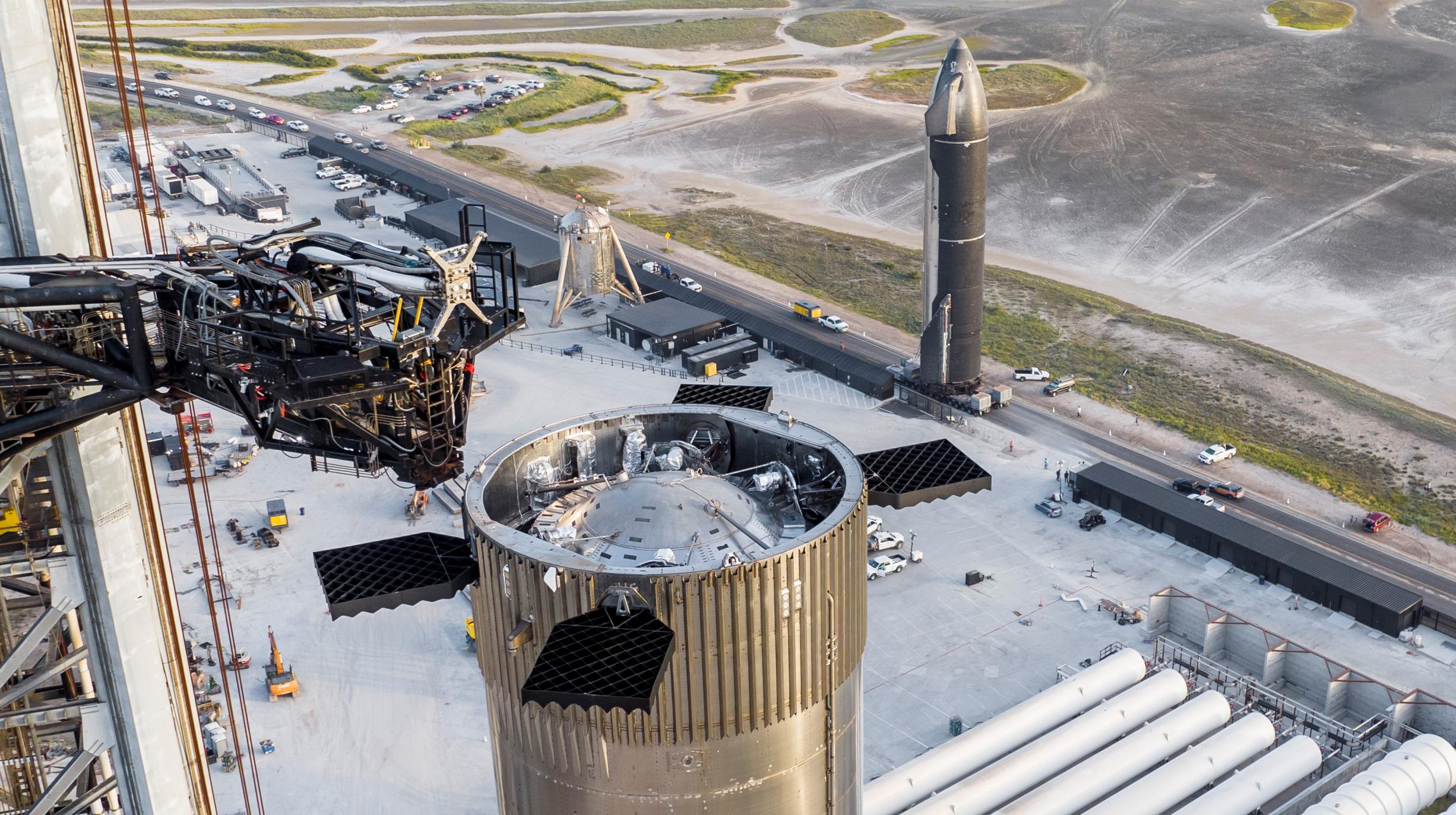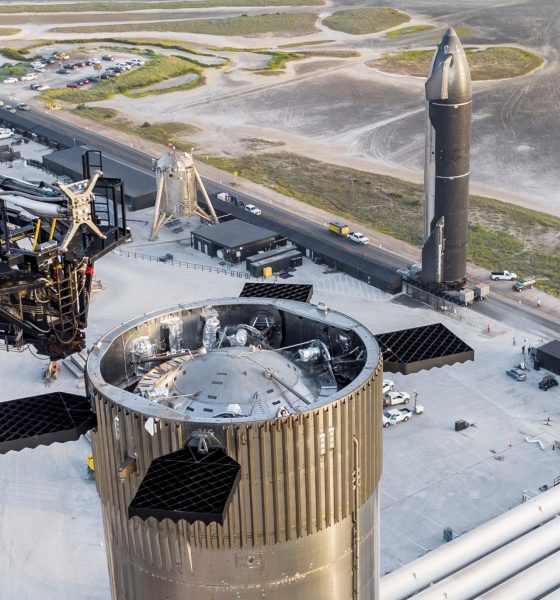

News
Elon Musk sets expectations for SpaceX’s first orbital Starship launches
CEO Elon Musk says that SpaceX’s first successful orbital Starship launch will “probably [occur] between 1 and 12 months from now,” revealing a surprising amount about the near future of the next-generation rocket program in a short tweet.
The famously (over)optimistic CEO’s latest Starship schedule estimate is uncharacteristically cautious, hedged, and open-ended while simultaneously setting some reasonable expectations about the likelihood of success.
First publicly unveiled in September 2016, the fully-reusable, next-generation rocket that eventually became today’s stainless steel Starship was tentatively scheduled to begin orbital flight testing in 2020. About two years after that first announcement, CEO Elon Musk unexpectedly sacrificed years of development work on Starship structures when he decided to replace the rocket’s carbon fiber composite airframe with stainless steel. Years later, it’s still hard to say if that decision was the right one, but Starship development has been surprisingly unperturbed by such an immense last-second design change.
While Musk was saying almost the same thing 12 months ago, the CEO now believes that Starship’s first orbital launch attempt could happen as early as next month – September 2022. Simultaneously, Musk believes that the first orbital launch attempt could be “successful,” although it’s not entirely clear how he defines “success.” Less optimistically, his August 2nd tweet also implies that he wouldn’t be surprised if it takes SpaceX a year and multiple attempts to achieve Starship’s first successful orbital launch.
It’s even possible to interpret his tweet as a warning that Starship’s first orbital launch – while more likely to be successful – could be up to 12 months away.
Somewhere in the middle (4-8 months from now) is a more reasonable bet for Starship’s first successful orbital launch. As of early August, no aspect of recent Starship or Super Heavy booster testing is particularly encouraging for a hypothetical September launch attempt: Super Heavy Booster 7 is still in the middle of repairs after surviving an accidental explosion, and Starship 24’s latest round of testing – while not yet destructive – has been sluggish.
If SpaceX (beginning on August 3rd) abruptly flips a switch and starts to test Ship 24 with some degree of urgency, it’s possible that the Starship could be cleared for the first orbital launch attempt by the end of August. Super Heavy is a much larger hurdle. Aside from the apparent removal of all of Booster 7’s 33 Raptor engines, which will likely take weeks to reinstall and re-cover, its status is somewhat ambiguous. If SpaceX decides to fast-track Booster 8, which is nearly ready for engine-less proof testing, the Super Heavy side of Starship’s orbital launch debut is probably at least two or three months away from flight readiness.
Realistically, assuming SpaceX isn’t going to take a massive risk and try to launch an unqualified or minimally qualified rocket, Starship’s first orbital launch attempt is unlikely to occur before October or November. It’s even harder to estimate whether Starship’s first full launch will be successful. If “success” is defined by simply reaching orbit or deploying a few next-generation Starlink satellites in orbit, SpaceX’s odds are not terrible. If success includes a Super Heavy booster catch and Starship surviving its first orbital reentry, they trend towards slim to none.
Perhaps SpaceX will defy the odds. Up next, Starship S24 is expected to begin static fire testing as early as August 3rd or 4th.

News
Tesla FSD (Supervised) v14.2.2 starts rolling out
The update focuses on smoother real-world performance, better obstacle awareness, and precise end-of-trip routing, among other improvements.

Tesla has started rolling out Full Self-Driving (Supervised) v14.2.2, bringing further refinements to its most advanced driver-assist system. The new FSD update focuses on smoother real-world performance, better obstacle awareness, and precise end-of-trip routing, among other improvements.
Key FSD v14.2.2 improvements
As noted by Not a Tesla App, FSD v14.2.2 upgrades the vision encoder neural network with higher resolution features, enhancing detection of emergency vehicles, road obstacles, and human gestures. New Arrival Options let users select preferred drop-off styles, such as Parking Lot, Street, Driveway, Parking Garage, or Curbside, with the navigation pin automatically adjusting to the user’s ideal spot for precision.
Other additions include pulling over for emergency vehicles, real-time vision-based detours for blocked roads, improved gate and debris handling, and extreme Speed Profiles for customized driving styles. Reliability gains cover fault recovery, residue alerts on the windshield, and automatic narrow-field camera washing for new 2026 Model Y units.
FSD v14.2.2 also boosts unprotected turns, lane changes, cut-ins, and school bus scenarios, among other things. Tesla also noted that users’ FSD statistics will be saved under Controls > Autopilot, which should help drivers easily view how much they are using FSD in their daily drives.
Key FSD v14.2.2 release notes
Full Self-Driving (Supervised) v14.2.2 includes:
- Upgraded the neural network vision encoder, leveraging higher resolution features to further improve scenarios like handling emergency vehicles, obstacles on the road, and human gestures.
- Added Arrival Options for you to select where FSD should park: in a Parking Lot, on the Street, in a Driveway, in a Parking Garage, or at the Curbside.
- Added handling to pull over or yield for emergency vehicles (e.g. police cars, fire trucks, ambulances).
- Added navigation and routing into the vision-based neural network for real-time handling of blocked roads and detours.
- Added additional Speed Profile to further customize driving style preference.
- Improved handling for static and dynamic gates.
- Improved offsetting for road debris (e.g. tires, tree branches, boxes).
- Improve handling of several scenarios, including unprotected turns, lane changes, vehicle cut-ins, and school buses.
- Improved FSD’s ability to manage system faults and recover smoothly from degraded operation for enhanced reliability.
- Added alerting for residue build-up on interior windshield that may impact front camera visibility. If affected, visit Service for cleaning!
- Added automatic narrow field washing to provide rapid and efficient front camera self-cleaning, and optimize aerodynamics wash at higher vehicle speed.
- Camera visibility can lead to increased attention monitoring sensitivity.
Upcoming Improvements:
- Overall smoothness and sentience.
- Parking spot selection and parking quality.
News
Tesla is not sparing any expense in ensuring the Cybercab is safe
Images shared by the longtime watcher showed 16 Cybercab prototypes parked near Giga Texas’ dedicated crash test facility.

The Tesla Cybercab could very well be the safest taxi on the road when it is released and deployed for public use. This was, at least, hinted at by the intensive safety tests that Tesla seems to be putting the autonomous two-seater through at its Giga Texas crash test facility.
Intensive crash tests
As per recent images from longtime Giga Texas watcher and drone operator Joe Tegtmeyer, Tesla seems to be very busy crash testing Cybercab units. Images shared by the longtime watcher showed 16 Cybercab prototypes parked near Giga Texas’ dedicated crash test facility just before the holidays.
Tegtmeyer’s aerial photos showed the prototypes clustered outside the factory’s testing building. Some uncovered Cybercabs showed notable damage and one even had its airbags engaged. With Cybercab production expected to start in about 130 days, it appears that Tesla is very busy ensuring that its autonomous two-seater ends up becoming the safest taxi on public roads.
Prioritizing safety
With no human driver controls, the Cybercab demands exceptional active and passive safety systems to protect occupants in any scenario. Considering Tesla’s reputation, it is then understandable that the company seems to be sparing no expense in ensuring that the Cybercab is as safe as possible.
Tesla’s focus on safety was recently highlighted when the Cybertruck achieved a Top Safety Pick+ rating from the Insurance Institute for Highway Safety (IIHS). This was a notable victory for the Cybertruck as critics have long claimed that the vehicle will be one of, if not the, most unsafe truck on the road due to its appearance. The vehicle’s Top Safety Pick+ rating, if any, simply proved that Tesla never neglects to make its cars as safe as possible, and that definitely includes the Cybercab.
Elon Musk
Tesla’s Elon Musk gives timeframe for FSD’s release in UAE
Provided that Musk’s timeframe proves accurate, FSD would be able to start saturating the Middle East, starting with the UAE, next year.

Tesla CEO Elon Musk stated on Monday that Full Self-Driving (Supervised) could launch in the United Arab Emirates (UAE) as soon as January 2026.
Provided that Musk’s timeframe proves accurate, FSD would be able to start saturating the Middle East, starting with the UAE, next year.
Musk’s estimate
In a post on X, UAE-based political analyst Ahmed Sharif Al Amiri asked Musk when FSD would arrive in the country, quoting an earlier post where the CEO encouraged users to try out FSD for themselves. Musk responded directly to the analyst’s inquiry.
“Hopefully, next month,” Musk wrote. The exchange attracted a lot of attention, with numerous X users sharing their excitement at the idea of FSD being brought to a new country. FSD (Supervised), after all, would likely allow hands-off highway driving, urban navigation, and parking under driver oversight in traffic-heavy cities such as Dubai and Abu Dhabi.
Musk’s comments about FSD’s arrival in the UAE were posted following his visit to the Middle Eastern country. Over the weekend, images were shared online of Musk meeting with UAE Defense Minister, Deputy Prime Minister, and Dubai Crown Prince HH Sheikh Hamdan bin Mohammed. Musk also posted a supportive message about the country, posting “UAE rocks!” on X.
FSD recognition
FSD has been getting quite a lot of support from foreign media outlets. FSD (Supervised) earned high marks from Germany’s largest car magazine, Auto Bild, during a test in Berlin’s challenging urban environment. The demonstration highlighted the system’s ability to handle dense traffic, construction sites, pedestrian crossings, and narrow streets with smooth, confident decision-making.
Journalist Robin Hornig was particularly struck by FSD’s superior perception and tireless attention, stating: “Tesla FSD Supervised sees more than I do. It doesn’t get distracted and never gets tired. I like to think I’m a good driver, but I can’t match this system’s all-around vision. It’s at its best when both work together: my experience and the Tesla’s constant attention.” Only one intervention was needed when the system misread a route, showcasing its maturity while relying on vision-only sensors and over-the-air learning.








